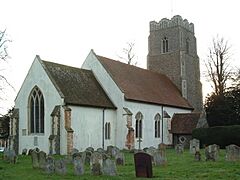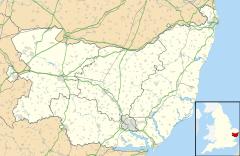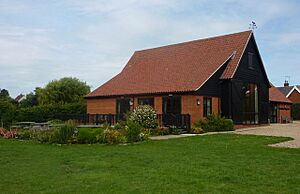Brandeston facts for kids
Quick facts for kids Brandeston |
|
|---|---|
 All Saints' Church, Brandeston |
|
| Area | 5.05 km2 (1.95 sq mi) |
| Population | 296 (2011) |
| • Density | 59/km2 (150/sq mi) |
| OS grid reference | TM2460 |
| Civil parish |
|
| District |
|
| Shire county | |
| Region | |
| Country | England |
| Sovereign state | United Kingdom |
| Post town | WOODBRIDGE |
| Postcode district | IP13 |
| Dialling code | 01728 |
| Police | Suffolk |
| Fire | Suffolk |
| Ambulance | East of England |
| EU Parliament | East of England |
Brandeston is a small village in Suffolk, England. It is located on the River Deben, about 18 kilometers (11 miles) northeast of Ipswich. The village is situated west of Kettleburgh and northwest of Hoo Green. Brandeston is a parish in the Plomesgate area, about 5.6 kilometers (3.5 miles) southwest of Framlingham.
Contents
Village History
Brandeston has a long and interesting history. The Brandeston Priory, a very old farmhouse, stands north of the village. It dates back to 1586 and is considered a special historical building.
Brandeston Hall is the biggest building in the village. It is now the junior school for Framlingham College. The original hall was badly damaged by a fire in 1847. It was then rebuilt to look exactly like the old one. This was done by its owner at the time, Charles Austin QC.
Just a few miles from Brandeston is Sutton Hoo. This famous site is where early English kings were buried. These kings led their people through the marshy lands near the River Deben. They also built their first settlements along its banks.
The number of homes in Brandeston has changed over many years. For example, in 1831 there were 64 homes. By 1841, there were 108 homes, but then it went down to 66 in 1851. A map from the 20th century shows Brandeston and nearby villages like Cretingham, Hoo, and Kettleburgh.
Churches in Brandeston
The main church in Brandeston is the Church of All Saints. It is a medieval church built in the Gothic style. It has a tall, square tower. There was also another chapel built in 1838.
The Church of All Saints needed repairs in the early 1600s. Later, between 1861 and 1863, the church was fully restored.
A vicar named John Lowes served in Brandeston from 1596 to 1645. During this time, he was accused of witchcraft. His story was later featured in the 1966 novel Witchfinder General by Ronald Bassett. This book was also made into a film two years later. Today, John Lowes' story is remembered on the village sign.
Who Lives in Brandeston?
In 2011, there were 296 people living in Brandeston. This included 144 males and 152 females. The average age of people living here was about 48 years old. Almost half of the residents were between 45 and 74 years old.
Over the years, the types of jobs people had in Brandeston have changed a lot. In 1831, many people worked as labourers or servants. There were also some employers and professionals. In 1881, most men worked in farming. Other popular jobs for men included working with houses or animals. For women, many jobs were in domestic services.
By 2011, the types of jobs were very different. Many people worked in professional roles. Others worked as managers, directors, or in administrative jobs. There were also people in skilled trades, caring, and sales.
Most people in Brandeston reported being in 'Very Good Health' in 2011. Many others said they were in 'Good Health'. Only a small number reported 'Fair' or 'Bad' health.
Brandeston in Stories
Brandeston is an important setting in Ronald Bassett's 1966 novel Witchfinder General. The story was also made into a film in 1968. However, the film was not actually shot in the village itself.
Famous People from Brandeston
- William Clubbe (1745–1814), a clergyman and writer of poems.
- Alan Greene (1856–1928), a well-known cricket player.
- William Verner Longe (1857-1924), a painter famous for his horse paintings.
- Ghillean Prance (1937- ), a botanist and ecologist. He was also the Director of the Royal Botanic Gardens, Kew from 1988 to 1999.
Images for kids







